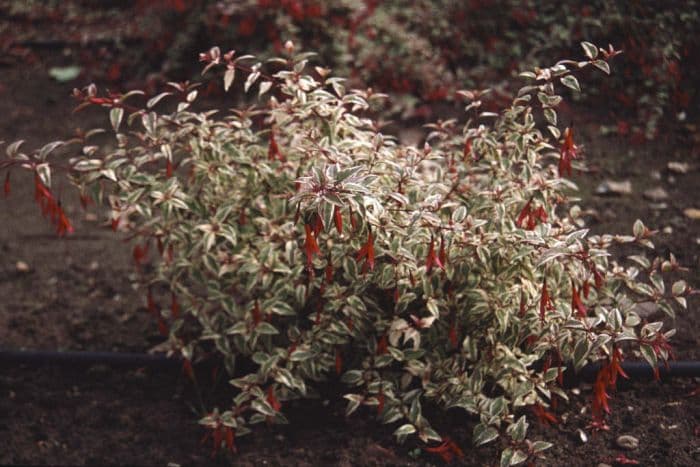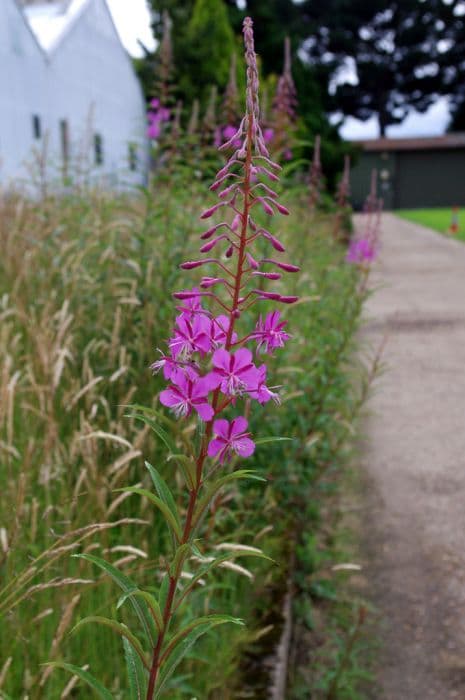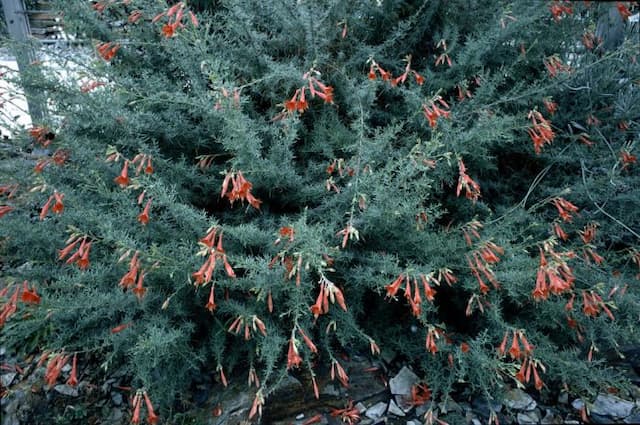Variegated Hardy Fuchsia Fuchsia magellanica var. gracilis 'Variegata' (v)

ABOUT
The Fuchsia magellanica var. gracilis 'Variegata' (v), commonly known as the variegated hummingbird fuchsia, is a visually striking plant. Its foliage is a standout feature, with leaves exhibiting a blend of green and cream variegation, which forms an eye-catching contrast. The edges of the leaves are often tinged with a creamy white or pale yellow hue that stands out against the darker green center. The variegated hummingbird fuchsia is also admired for its enchanting flowers that dangle gracefully from the branches. These pendulous blooms typically have a two-tone color pattern. The outer petals, or sepals, are usually a vibrant, deep pink or purplish-red hue, while the inner petals, or corolla, have a rich shade of purple or sometimes a deep pink. The long, slender flowers hang downwards, resembling small, elegant lanterns. Overall, the plant's combination of variegated foliage and striking flowers provides a lush and colorful display that can add a touch of elegance and vibrancy to any garden environment.
About this plant
 Names
NamesSynonyms
Variegated Hummingbird Fuchsia, Variegated Lady's Eardrops, Variegated Hardy Fuchsia
Common names
Fuchsia magellanica var. gracilis 'Tricolor', Fuchsia magellanica 'Tricolor', Fuchsia magellanica 'Variegata'.
 Toxicity
ToxicityTo humans
The most common common name for Fuchsia magellanica var. gracilis 'Variegata' is Hardy Fuchsia. Hardy Fuchsia is not considered toxic to humans. Therefore, ingestion of this plant typically does not result in poisoning or adverse symptoms.
To pets
For pets, Hardy Fuchsia is also non-toxic. It is generally considered safe, and there are no well-known toxic effects associated with pets ingesting this plant. Consequently, there are no specific symptoms of poisoning or dangerous consequences expected if pets consume parts of the Hardy Fuchsia.
 Characteristics
CharacteristicsLife cycle
Perennials
Foliage type
Deciduous
Color of leaves
Variegated
Flower color
Mixed
Height
2-3 feet (60-90 cm)
Spread
2-3 feet (60-90 cm)
Plant type
Shrub
Hardiness zones
6-9
Native area
Southern Chile, Argentina
Benefits
 General Benefits
General Benefits- Aesthetic Appeal: Adds a splash of color to gardens with its distinctive pink and purple flowers.
- Attracts Wildlife: Draws hummingbirds and butterflies, promoting biodiversity.
- Low Maintenance: Requires minimal pruning and is easy to care for once established.
- Tolerance: Able to grow in cooler climates and can tolerate light frost.
- Versatility: Suitable for planting in borders, hanging baskets, and as a specimen plant.
- Long Blooming Season: Produces flowers continuously from summer to early fall.
- Shade Tolerance: Can thrive in partial shade in addition to full sun.
- Vibrant Variegation: The variegated foliage adds visual interest even when not in bloom.
 Medical Properties
Medical PropertiesThis plant is not used for medical purposes.
 Air-purifying Qualities
Air-purifying QualitiesThis plant is not specifically known for air purifying qualities.
 Other Uses
Other Uses- Fuchsia magellanica 'Variegata' can be used as a natural dye for textiles, providing pink to purple hues depending on mordants used.
- This plant can be incorporated into educational activities, such as teaching about plant variegation, due to its variegated leaves.
- It serves as a muse for artists and photographers, showcasing the captivating contrast between its foliage and pendulous flowers.
- Due to its unique appearance, Fuchsia 'Variegata' can be used as a theme for garden parties or botanical events.
- Its branches and leaves can be used in the creation of intricate fairy gardens or miniature landscapes.
- The plant can be part of a study on the adaptability and growth patterns of various plant species in different climates.
- Fuchsia 'Variegata' is useful in permaculture designs, acting as a beneficial insect attractor to enhance garden ecology.
- It can inspire the design of botanical prints for fabrics, wallpapers, and stationery, reflecting its distinctive foliage and flower shapes.
- The plant might be used in floral language or floriography, symbolizing confiding love or good taste.
- It can be a living gift to represent a hobby or interest in gardening, especially for those who appreciate variegated leaves.
Interesting Facts
 Feng Shui
Feng ShuiThe plant Fuchsia is not used in Feng Shui practice.
 Zodiac Sign Compitability
Zodiac Sign CompitabilityThe plant Fuchsia is not used in astrology practice.
 Plant Symbolism
Plant Symbolism- Elegance: The graceful drooping flowers of 'Variegata' evoke a sense of refined beauty and sophistication.
- Vibrancy: With its vivid colors, the fuchsia represents liveliness and positive energy.
- Good Taste: Often found in ornamental gardens, fuchsias can symbolize a person's refined aesthetic sense and good taste.
- Confiding Love: Victorians might have used fuchsia to communicate trust and confiding love in the language of flowers.
 Water
WaterThe hardy fuchsia, specifically 'Variegata', requires consistent moisture without being waterlogged. It should be watered thoroughly whenever the top inch of soil feels dry to the touch, which often equates to about once or twice a week depending on climate conditions. During the growing season in spring and summer, aim to provide approximately 1 gallon of water for a medium-sized plant each week, though this can vary based on temperature and humidity. Reduce watering frequency in the fall and winter when the plant's growth slows down, being careful not to let the soil dry out completely.
 Light
LightHardy fuchsia thrives in partial shade to dappled sunlight settings. It should be positioned where it receives morning sun and afternoon shade, or bright, indirect light throughout the day. Avoid exposing 'Variegata' to the intense midday sun, which can scorch its leaves.
 Temperature
TemperatureHardy fuchsia, including the 'Variegata' variety, prefers temperatures between 60°F and 75°F for optimal growth. It can survive minimum temperatures down to about 40°F, but frost can damage the plant. While it is adaptable to various conditions, it thrives best in cool summers and mild winters without extended periods of heat.
 Pruning
PruningPruning maintains the shape of hardy fuchsia and encourages bushier growth. 'Variegata' should be pruned in late winter or early spring before new growth begins. Cut back approximately one-third of the plant to promote new stems and flowers. Pruning can also remove any dead or damaged wood and help control the size of the plant.
 Cleaning
CleaningAs needed
 Soil
SoilThe best soil mix for Hardy Fuchsia (v) is one that is well-draining, fertile, and humus-rich. Aim for a soil pH between 6 and 7.5. A mix of peat moss, compost, and perlite or vermiculite can provide the appropriate texture and nutrients needed for optimal growth.
 Repotting
RepottingHardy Fuchsia (v) needs to be repotted every two to three years, or when it has outgrown its current pot. Repotting should be done in spring before new growth begins.
 Humidity & Misting
Humidity & MistingHardy Fuchsia (v) prefers high humidity levels, ideally between 60% and 70%. The plant thrives with consistent ambient moisture but without wetting the foliage directly.
 Suitable locations
Suitable locationsIndoor
Place in bright, indirect light, keep soil moist.
Outdoor
Partial shade, sheltered from wind, moist soil.
Hardiness zone
6-10 USDA
 Life cycle
Life cycleThe life cycle of Fuchsia magellanica var. gracilis 'Variegata', commonly known as Variegated Hummingbird Fuchsia, begins with seed germination in moist, well-draining soil, preferably in spring when temperatures are mild. Seedlings emerge and gradually mature into bushy shrubs that can reach up to 10 feet tall with partial shade and adequate water. As the plant grows, its distinctive variegated leaves develop, featuring a mix of green and creamy white or yellow margins. In late spring to early summer, the plant produces pendant, tubular flowers that are typically red and purple, attracting pollinators such as hummingbirds. After pollination, the flowers give way to small, dark-purple fruits that are seldom produced in cultivation. In regions with mild winters, the Fuchsia magellanica 'Variegata' behaves as a perennial, while in colder climates, it must be protected or treated as an annual.
 Propogation
PropogationPropogation time
Spring-Early Summer
The hardy fuchsia, known as Fuchsia magellanica var. gracilis 'Variegata', is commonly propagated by softwood cuttings, which is the most popular method. This process typically takes place in late spring to early summer when the plant's new growth is green and pliable. Cuttings should be taken from fresh, new growth, about 4 to 6 inches long, making the cut just below a leaf node. The leaves at the lower end of the cutting are removed, and the stem is dipped in rooting hormone before being placed in a well-draining soil mix. To maintain humidity, cover the cuttings with a plastic bag or place them in a propagator. Rooting generally takes place within 3 to 4 weeks, at which point the cuttings can be potted up individually.









